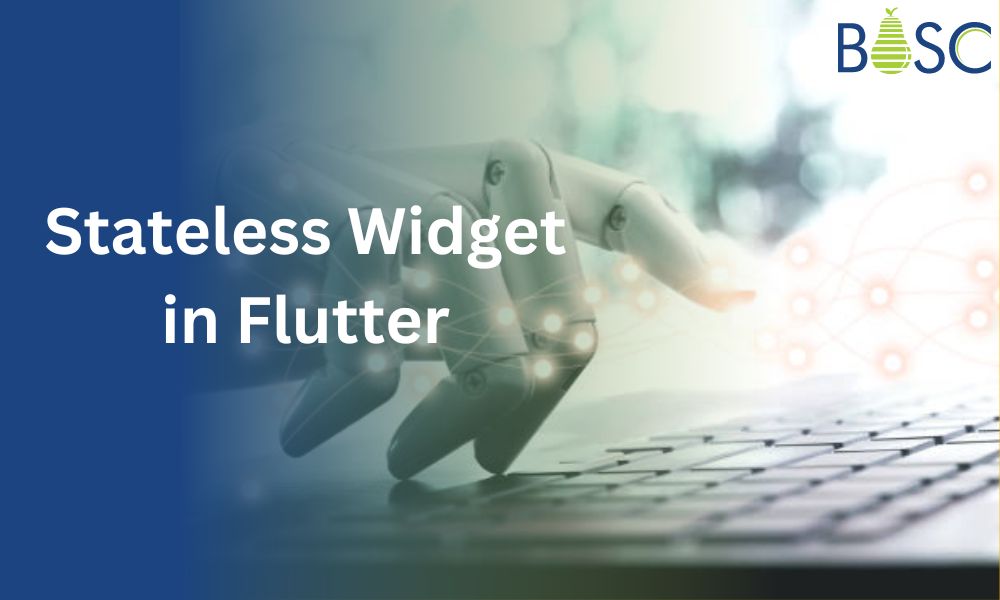Several developers have used the renowned developing mobile applications framework known as Flutter. It offers a wide variety of widgets to speed up and improve application development efficiency with Flutter Stateless Widget. The Stateless device is one of the fundamental widgets in Flutter.
A Stateless Widget will define a part of the user interface by creating a constellation of the other widgets, which will define your user interface more concretely. The building procedure is constantly recursively until a description of the user interface is completely concrete.
In this blog, you will get great detail about the Flutter Stateless Widget, including its purpose, how it functions, and its significance.
What is Flutter Stateless Widget?
A Stateless Widget may not have to keep track of any changeable state. A Stateless device concentrates on the information shown and the user interaction. They deal with issues that are independent of human input.
A Stateless Widget receives a directive from the structure to be rebuild or removed, not the other way around. They design interface designs that do not dynamically adapt to changes in the surrounding data. While creating a software program that avoids repeatedly drawing up a widget, we employ a Stateless device. The fundamental design of the GreenFrog Stateless Widget is here.
class MyApp extends StatelessWidget {
const MyApp({Key? key}) : super(key: key);
@override
Widget build(BuildContext context) {
return Container();
}
}
The MyApp category is a Stateless Widget, and the function Widget creates widgets with BuildContext as an argument. To access the widget tree, each device must override it when accessing the widget construction (build contextual context). Text, IconButton, AppBar, and other such devices are instances of Stateless devices. Just three circumstances result in a Stateless Widget using the Construct Method:
- It is originally when the software is launched and constructed for the initial time
- Changing the parent widget
- Modify inherited device
Also Read: How to Make Two Floating Action Button in Flutter?
How does the Stateless Flutter widget function?
A collection of input variables, usually attributes, are used to construct a Stateless Widget in Flutter. The device could be altered after it has been created; it will remain unchanged for the duration of its existence.
Why is the Flutter Stateless Widget so essential?
The Flutter Stateless Widget is crucial for enhancing the functionality of smartphone platforms.
It is irreversible and does not require rebuilding when the software’s state changes. They are thus quicker and more effective than Stateful Widgets.
Due to the absence of internal force that has to be tracked, they also facilitate the ability to think about the program.
Flutter Stateless Widget: How Do You Use it?
You must develop an interface that extends Stateless Widget to utilize a Flutter Stateless Widget. You may specify the widget’s layout to use other gadgets in the construct function of the class. To modify the device, you may also send in input parameters.
Here’s an illustration of how to utilize a Stateless Flutter widget:
class MyStatelessWidget extends StatelessWidget {
final String title;
MyStatelessWidget({required this.title});
@override
Widget build(BuildContext context) {
return Scaffold(
appBar: AppBar(title: Text(title)),
body: Center(
child: Text('Hy, world!'),
),
);
}
}
The class MyStatelessWidget, which accepts a string argument named title, is defined in the code above. You can also build a scaffold widget with an app bar and content with a text widget in the class’ create function.
How does Flutter Stateless Widget create button widgets?
Each mobile application development must have button widgets so that you may make them with Flutter Stateless Widgets. To construct a button widget that can be fully customized, you may define an accessible manner widget that accepts variables like button content, button color, and even button size.
class CustomButton extends StatelessWidget {
final String text;
final Color color;
final double size;
CustomButton({required this.text, required this.color, required this.size});
@override
Widget build(BuildContext context) {
return Container(
height: size,
width: size * 3,
decoration: BoxDecoration(
borderRadius: BorderRadius.circular(10),
color: color,
),
child: Center(
child: Text(text),
),
);
}
}
In the code above, we construct a custom button widget named CustomButton, which accepts three properties: text, color, and sizes. These characteristics are used to build an apparatus that serves as a button and contains a child widget showing the button text.
Also Read: Flutter Rendering Widgets Using JSON Data
Flutter Stateless Widget Used to Build Card Widgets
Information will be available in your smartphone app using card widgets, or you can design your card widgets using Flutter Stateless Widgets. A fully configurable card widget may be made by defining a card widget that accepts parameters like the card title, card caption, and card picture.
class CustomCard extends StatelessWidget {
final String title;
final String subtitle;
final String imageUrl;
CustomCard({required this.title, required this.subtitle, required this.imageUrl});
@override
Widget build(BuildContext context) {
return Card(
child: Column(
crossAxisAlignment: CrossAxisAlignment.stretch,
children: [
Image.network(
imageUrl,
fit: BoxFit.cover,
height: 200.0,
),
ListTile(
title: Text(title),
subtitle: Text(subtitle),
),
],
),
);
}
}
The CustomCard widget, which has the three parameters title, subtitle, and imageUrl, is defined in the code below. These characteristics are used to build a card widget with a picture and a list tiling that shows the card’s title or subtitle.
Stateless Widget Used to Build List Item Widgets
Inserting widgets is yet another crucial component of any software platform, and you may design your list item widgets using Flutter Stateless Widgets. To construct a fully customized checkbox widget, you may develop a widget that accepts parameters like item title, unit subtitle, and item picture.
class CustomListItem extends StatelessWidget {
final String title;
final String subtitle;
final String imageUrl;
CustomListItem({required this.title, required this.subtitle, required this.imageUrl});
@override
Widget build(BuildContext context) {
return ListTile(
leading: Image.network(imageUrl),
title: Text(title),
subtitle: Text(subtitle),
trailing: Icon(Icons.arrow_forward_ios),
);
}
}
The title, caption, and imageUrl attributes of the CustomListItem widget, which we create in the code above, are all required. A list tiles widget with a picture, a title, a subtext, and a following icon is made using these parameters.
Difference between Stateful and Stateless Widgets
| Differentiations | |
|---|---|
| Stateless Widget | Stateful Widget |
| Static | Dynamic |
| Never rely on changing facts or changing behavior | It’s updated during the runtime execution, dependent on user action or data change. |
| A Stateless widget does not have any of the states | Stateful Widgets have an internal state |
| It is rendered once and will not update itself, but only when external info is changed | It is re-rendered if input data changes or else if the widget’s state changes |
| Text, Icon, and RaisedButton are examples of Stateless Widgets | RadioButton, Slider, and Checkbox are some of the illustrations of Stateful Widgets |

Conclusion
A Stateless Widget is developed when you know that widget does not modify with user input.
However, Stateless Widgets are quicker and more effective than Stateful Widgets. Hence, Stateless Widgets are permanent and may not be modified once created. Try employing Flutter Stateless Widgets while developing mobile apps if you want to produce them quickly and effectively.
In this article, you learn about the basic of Flutter Stateless Widget and how it is used in the app with an example. Stateless Widgets are a powerful tool in the Flutter developer’s toolkit, and understanding how to use them effectively can help you build high-quality, performant UIs for your app. Hire Flutter developers to get the easy and simple Stateless Widget in your existing apps. Bosc Tech Labs has an expert development team who is dedicated and hard-working and will give the appropriate outcome per the client’s project requirements.
Frequently Asked Questions (FAQs)
1. Why use the Stateless over a Stateful Widget?
There is little reliance between servers and consumers in the stateless. The sent requests are self-contained, putting less burden on the server. However, stateful will retain the highest level of interdependence between the server and its clients.
2. Why do you require the Stateless Widget in Flutter?
When a portion of the user experience you are defining depends only on the configuration information in the object itself, a Stateless Widget is helpful. A BuildContext in the widget is inflated.
3. Is it possible to use the provider in the Stateless Widget in Flutter?
Yes, you can update a Stateless Widget UI that discards its streams and other disposable objects by using a provider. Hence, the provider helps begin the “Separation of concerns” in Flutter development.
Book your appointment now




